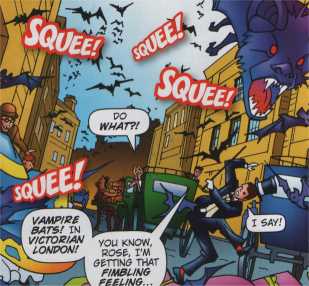
Doctor Who Adventures
Bat Attack! / The Battle of Reading Gaol
Reviews and links from the Community
This review contains spoilers
Review of Bat Attack! / The Battle of Reading Gaol by deltaandthebannermen
The Doctor Who Adventures’ comic strips are probably one of those areas of storytelling that a large majority of Doctor Who fans haven’t experienced. They are a mixed bag. The stories are often simplistic and fairly similar in their plot beats. But one thing they do achieve is to explore a far wider range of locations and periods than the TV series will never have time to do. Now, whilst the 19th Century is definitely not a period of history that the TV series has neglected to visit, engaging with actual historical figures from that era has not been as common an occurrence. Stories such as The Talons of Weng-Chiang, The Snowmen and Deep Breath are more concerned with the atmosphere of Victorian London; the literary version so closely tied to Sherlock Holmes; the gaslit, fogbound cobbled streets of mystery and dark deeds.
Bat Attack and The Battle of Reading Gaol, a two part comic strip from DWA bucks this trend. The story opens as if it will be a Sherlock Holmes-inspired visit to the 19th Century with the first frame featuring Inspector Lestrade and Rose referring to the Doctor as Sherlock. Unusually this frame also finds us joining the Doctor and Rose at the end of an adventure where they have apparently foiled the plans of the two-faced Professor Janus (looking similar to the alien race recently introduced in Face the Raven). As they make their goodbyes they find themselves in the midst of a vampire bat attack on a London street.
The writer, Alan Barnes, plays a very clever game here, probably aware his readership is going to include adult Doctor Who fans. We are lead, much as the Doctor and Rose are, to expect this story to be a pastiche on Dracula (another 19th Century literary staple). Charging into the Lyceum Theatre, the Doctor and Rose encounter Bram Stoker and Henry Irving. Suddenly they are all confronted by Frederick von Dracula – a direct descendant of Vlad the Impaler (as seen in Son of the Dragon). But he is not a vampire. He is merely a human determined to defend his family’s name which he feels Stoker is ruining through his new novel about Dracula.
But there is a real vampire present – Florence, Stoker’s wife, is a vampire and stops von Dracula from shooting an arrow at Stoker and the Doctor.
And then the story takes a very odd turn. The question is raised as to who made Florence into a vampire and it is revealed to be Oscar Wilde! This leads into the second part of the comic strip in the following issue of DWA where the Doctor, Rose and Florence go to Reading Gaol to liberate Wilde from his incarceration (after a ‘terrible scandal’).
So now, Wilde is a vampire, the gaol is being run by vampires and the Doctor cures them all by burping.
Excuse me!
It’s absolutely bonkers!
It isn’t explained why Wilde is a vampire, although the TARDIS wikia suggests it is all a metaphor for Wilde’s homosexuality. Whilst this didn’t really occur to me when reading the strip, it is a valid interpretation. As I mentioned, the strip states Wilde is in prison due to a ‘terrible scandal’ and those with knowledge of Wilde’s real world history will know this was his punishment for being homosexual.
The ‘burping’ resolution is very DWA. Many of their strips are resolved in a similarly cursory manner but to be fair, it isn’t any less convincing than the magical medicine ending of New Earth or the flick a switch ending of The Vampires of Venice – or Inside the Spaceship, for that matter.
Historically, this story has a lot going on. As I’ve said, characters featured include: Bram Stoker, Florence Stoker, Henry Irving and Oscar Wilde, as well as, the fictional, Inspector Lestrade. Two real locations are the Lyceum Theatre and Reading Gaol. Bram Stoker was a business manager at the Lyceum Theatre from 1879 to 1898. Irving was the inspiration for Stoker’s characterisation of Dracula. Stoker hoped Irving would play Dracula in a stage version of the story but he declined. What’s interesting is that, in the comic strip, a stage version is being rehearsed and Irving is sitting in the stalls watching with a face full of disdain. There is a definite hint to real life history in the way he is presented in the comic strip (although after this point he disappears from the narrative).
The title of the second part of this comic strip is also a clever link to real history. It is titled The Battle of Reading Gaol and after Wilde was incarcerated in the prison, he wrote a poem called The Ballad of Reading Gaol. In real life history, Wilde was indeed released from prison in 1897 when this story is set.
The characterisation of the 10th Doctor and Rose is okay, if a little generic, and the artwork for the strip is standard for this period of DWA (drawn by John Ross). Overall this is a strong, if bonkers, comic strip from the DWA stable. It works with some intriguing minor historical details, a bit of Victorian grotesque and some real life characters to provide a fun strip which, unlike some DWA output, works for both adults and children alike.
Community Ratings
(Updates coming soon:)
Add the last X members who rated it here
Add number of Favs, and who they are, here







